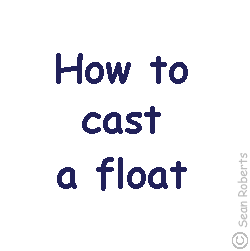
fig 2.1
fig 2.2

Overhead Casting An Overview
CASTING OUT most situation will only call for a side cast but some times you will be called on to make a longer cast say on a wide river or big lake and then you'll need to make a overhead cast to get the required distance to where your fishing.
the most important factor is accuracy so pick a target to focus on and allign your cast to that object be it a shaddow or bush on the far bank to ensure you cast to the same area each sucessive cast , lift your rod uprite then tilt it back with your tackle hanging 12in - 18in below the tip and with the butt pointed at your desired fishing area looking at the area whilst you cast with enougth energy to reach the desired spot.
having made the cast in the first stage , the release of the line will be of importance in obtaining the maximum distance and accuracy.and the point of release will come at the moment the rod reaches its very final point of travel with the tackle having just come past the tip and it is begining its forward motion of travel.
the control of the cast is all important to prevent the tackle going to far or landing in a heap and resulting in a birds nest of a tangle , as the tackle aprotches the waters surface you should check the line so as to make main weight of the tackle pause in flight slightly and to allow any lighter split shots to over take the float as it lands on the water this feathering of the line is achieved by tapping the spool with your index finger tip against the rim of the spool this will make the tackle land in a strait line avoiding tangles and allowing your bait to fall through the water in a natual manner.
final stage of the cast depends on the type of fishing your doing , if your waggler fishing you should of over cast your fishing area by a few feet then as the tackle lands and begins to settle you close your bail arm on your reel and push the tip of your rod under the surface of the water and quickly give your reel a few turns of the handle to sink the trailing line and to pull your tackle back into your fishing area.
if your stick float fishing then you would off cast up stream of your baited area liveing your bail arm open to allow line to peel off as the float travels through your swim the as you either strike into a fish or just want to reel in to recast you would close your bail arm.
if your feeder fishing or ledgering then as your takle hits the water you would lieve the bail arm open so the tackle can sink freely to the bottom because if you close your bail arm the heavy weight on the end of a tight line would swing back towards you in a arc as it falls down through the water to the bottom , and when using a opened ended feeder try not to snatch at your cast as this will empty your feeder midflight or as it enters the water and spread your feed over a wide area.
only practice will get it all working correctly and smoothly.and try to learn to cast from a seated position.
THE SIDE CAST
fig 3

The Side Cast An Overview
the side cast is achieved by lifting your rod to a 45 degree angle then sweep it back behind you in a level arc then with your tackle swinging low under your tip and your body twisted sidways on , then in a continous sweeping arc swing out your tackle until your rod is pointing in the direction of your chosen swim and then release the line remembering to feather the line as it lands on the water to get the correct presentation of your terminal tackle.
Copyright © 2006 Steven Devereux. All Rights Reserved.
